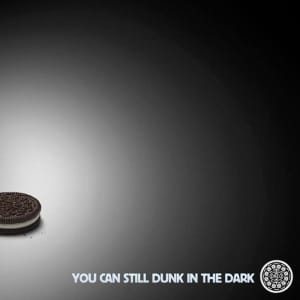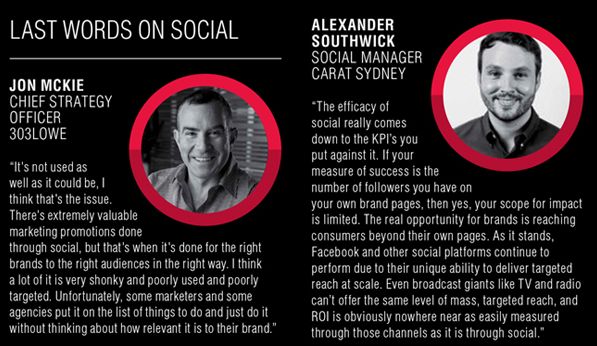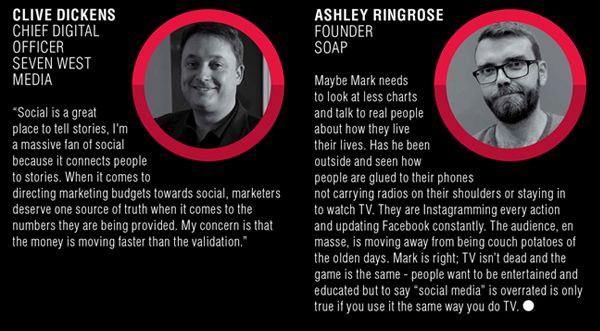
Are social media and digital over-rated and out-dated? Brand consultant Mark Ritson thinks so, but how valid are his claims? Sarah Homewood explores the fallacy.
Mark Ritson is waiting for someone to prove him wrong. In November, he stood up at the 2015 Media Forum in Canada and explained why he thinks social media is overrated, digital media is outdated and why marketers need to get back to integration and media neutrality. However it’s been nearly three months and there hasn’t been much in terms of a rebuttal.
This also isn’t the first time that Ritson, a marketing professor at Melbourne Business School and a brand consultant, has called out brands' great rush towards social without the numbers stacking up.
“It just seems like no one else is saying it - so I’ll keep saying it,” he says. “When I first did the talk in Australia I figured someone would put me in my place and explain why I was an idiot, but no one did.”

His point is that marketers keep ploughing more dollars into channels that don't deliver. His numbers make a strong point. He outlines a click through rate of just 0.45% on tweets for brands that have more than 10,000 followers, and is particularly aggrieved by the social media moment that birthed the buzzword “newsjacking”. The Oreo cookie moment, during the 2013 Super Bowl. Ritson says he looks at this specific moment because it’s the one that the trade press called “the tweet that was heard all around the world”. As well as having a gripe with social, Ritson also takes issue with the trade press (that includes us and UK trade title Marketing Week, which he also writes a regular column for) for fuelling the hype around social.
Ritson’s main bugbear with the advertising and marketing trade press comes from how much social is reported on compared with the proportion of marketing spend it recieves. Players such as Facebook and Twitter, he claims, gain 50% of the share of voice from the trade press, yet only make up 10% of spend.
Doing the maths based on data from 2013, Ritson deducts that appropriately 64,300 people saw that Oreo tweet that day, not including all the media attention the moment subsequently got. Comparing that number to the total audience of the Super Bowl, some 108 million people, and the ads that are played during it, he is not impressed by the so called “winning” social moment. But boiling down the numbers, it reached just 0.02% of the brand’s target market in the US while a Budweiser TV ad which ran during the same Super Bowl and reached 47% of viewers (that’s 50 million viewers.)
“I’m not saying it wasn’t a nice little piece of advertising, it was awesome," he told the Media Forum in Canada. "What I’m saying is on what fucking planet does that win the award for the best and most impactful thing in the Super Bowl?”

The social spaceship
There are of course those who believe in the power of social and what brands can do with it. The problem, they say, isn’t the medium, but how it’s being used.
Soap Creative has a heavily digital focus so unsurprisingly its founder Ashely Ringrose doesn't buy into Ritson's rhetoric.
"The world isn't black and white, it’s grey. Social media isn't overrated, it’s just not being used to full potential by 63% of brands. I’d love to hear Mark’s thoughts on social media and its impact on the luxury brands he works with at LVMH. I doubt they will say it’s overrated. More so it’s impacting them heavily (both good and bad) and they need to embrace it more," he said.
Managing director at We Are Social, Susie Shaw, is also unsurprisingly a cheerleader for social and digital. Ritson believes that social is a place for people - not brands. Shaw disagrees.
“Above all, it is a place where brands can reach large audiences, at high frequency, at relatively low cost. Currently over 50% of all media consumption is online and 60% of that is in social or on blogs so simply its ability to get eyeballs is strong,” Shaw says.
If predictions are anything to go by, more than a third of CMOs say digital marketing will account 75% or more of their spend within the next five years, according to the CMO Council.
And 69% of senior marketers say they are currently allocating digital marketing funds to website content, development and performance optimisation. With 53% spending part of their budget on social media community growth and engagement.
Shaw notes that spend on digital and social continues to rise because marketers inherently believe it works. “The innovation that it delivers also provides opportunities for marketers to be far more sophisticated in their approach to targeting and innovation. Marketers are realising, why take a horse and cart when there’s a spaceship available? It’s the future,” she added.
Rigour and ROI
To tackle this new social world Ritson is adamant that marketers shouldn't be afraid to ask questions around rigour and what is actually delivering ROI. He suggests what's missing in modern marketing is "the rigour of a discipline that questions every dollar that’s being spent."
Ritson believes brands need to strip out marketing budgets in order to ensure money isn’t spent for the sake of it. Believing that when a brand has a dollar figure around what it's going to spend on social means they are going to blow it, whether they need to or not.
One company that believes in this school of thought is Unilever, with its CEO Paul Polman announcing in January the business would adopt a zero-based budgeting programme. The move will see marketing managers having to justify their marketing budgets every year.
Stripping out the word digital is another way to go, according to Ritson, who believes that integration and media neutrality will "re-emerge and reset the agenda", but that it's at least a year away. Ringrose, however, isn't convinced of the ROI argument either.
"You can find just as many charts saying social is greater than TV as you can the opposite. Each one funded by a self interested party hoping to support their medium. I bet the radio networks and newspapers have amazing stats to show how they are actually much more relevant than you’d think."
A digital trends report rolled out by research group eMarketer late last year, highlighted the 2016 Rio Olympics as well as the US presidential election, will keep TV spending above digital for another year.
Closer to home TV still trumps social by a long way, however in 2015 social spend spiked more than 50% year-on-year. According to SMI data, in the 2015 calendar year agencies spent $150.9 million on social networking websites, an increase of 59.2% from 2014. When it comes to TV however, agencies spent $3.61 billion across TV in the same period.'
Lenova defends social
Lenovo is one brand that has backed social and believes that its numbers back-up the spend.
In late 2014, Lenovo launched its first consumer products in the Australian market. The business weighted 60% of its marketing budget towards digital and social, with another large chunk going towards retail. Lenovo’s Asia-pacific marketing head, Nick Reynolds, believes the numbers speak for themselves. Lenovo is now number two in retail in Australia and brand awareness increased from 14% to 44% in 12 months.
The brand led with digital and social because it was an unknown brand with 1% share of voice. The brand was being outspent in traditional media by its competition, Apple and Samsung, and if the brand tried to compete its budget would be spread too thin and wouldn't cut through.
“We make some great technology and it's also a bit weird, a bit disruptive. So our brand is disruptive, our product is disruptive and it's cutting through to the right audience. It's been the most successful consumer launch for Lenovo in the last two years,” he said.
Have something to say on this? Share your views in the comments section below. Or if you have a news story or tip-off, drop us a line at adnews@yaffa.com.au
Sign up to the AdNews newsletter, like us on Facebook or follow us on Twitter for breaking stories and campaigns throughout the day.


